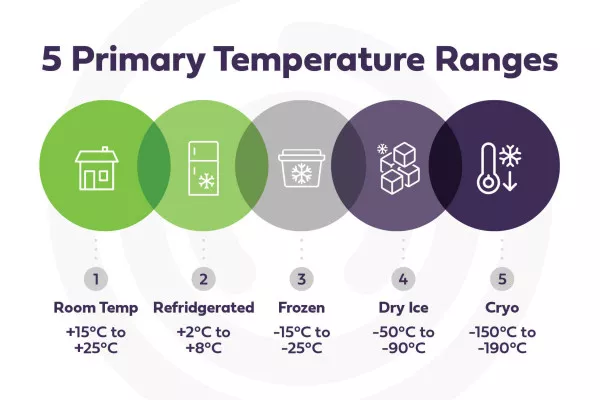- News
- Q & A on Temperature Control Solutions: Packaging, Shipping,…
News
Q & A on Temperature Control Solutions: Packaging, Shipping, and Logistics
Recently we sat down with Andy Kappus, Director of Temperature Control Solutions, to talk about the importance of temperature control and the role it plays in the healthcare logistics industry, especially in terms of delivering medical samples or specimens to a lab to be processed.
What is Temperature-Controlled Shipping?
Can you give us an overview of what temperature-controlled shipping is?
Temperature-controlled shipping involves maintaining a specific climate environment for a set duration of time. Depending on what type of commodities are being shipped, different temperature ranges are required. Those temperature ranges vary and are often described as controlled room temperature (15°C to 25°C), refrigerated (2°C to 8°C), frozen (-15°C to -25°C), dry ice (-50°C to -90°C) or cryo (-150°C to -190°C).

How does BioTouch handle this process with its temperature control methods?
BioTouch takes a layered approach to maintain specific climate conditions for our customers. We first start off by utilizing vacuum-insulated packaging (VIP’s) that has been independently tested against an ISTA 7D summer and winter profile to achieve a five-day validation. Our shippers are carefully preconditioned at our temperature service center to ensure that the phase-changing materials (PCM’s) have been adequately exposed to the required temperatures for at least 72 hours.
In addition, we have implemented extra precautions to strengthen the packaging, ensuring it can withstand the challenges of being transported through a fast-paced cargo network. The height of drop tests in different industries may range from 3.9 to 5.9 feet, depending on the packaging category. However, we have conducted tests where our packaging successfully endured drops from heights exceeding 9.9 feet. Our objective in implementing these additional measures is to prevent the accidental opening of the packaging when a box falls off a conveyor belt.
Our top priority is equipping our operations team with dynamic data loggers to actively monitor every package in live time. We utilize telemetrics to furnish the geographical coordinates and internal temperature of each sender, employing a blend of GPS, Cellular, and Wi-Fi networks. These devices have been successfully deployed in remote corners of the globe, transmitting data from six out of the seven continents, with Antarctica being the sole exception.
When a package is getting too hot or too cold, these data loggers that are in use will send an alert. In response, our logistics team will take action and send one of our 3,000 drivers to remove the package from its intended path. We will then place the package in a controlled environment and discuss with the customer how they would like us to proceed with the final delivery.
Challenge: Dry Ice is Not a Reliable Method of Temperature Control
It used to be standard practice to pack and ship using dry ice. Why is that not a reliable method for temperature control?
Dry ice is frequently used throughout the industry to ship frozen medical and biopharma items. Dry Ice is a solid form of carbon dioxide that can maintain a temperature range between -50°C and -90°C. Depending on the quality, dry ice sublimates (melts) at a rate of about five to ten pounds per day when shipped in a styrofoam cooler. Dry ice is considered a hazardous material and has a negative environmental impact when used in excess.
Due to hazmat regulations and restrictions by the airlines, most shippers will only use enough dry ice to last them two to three days in transit. Unfortunately, what happens far too frequently is that any delay in the supply chain will cause the dry ice to dissipate before the delivery occurs. If a dry ice order is delayed, shippers will often request to have the dry ice replenished. This type of dry ice rescue replenishment is not easy to perform and is not typically feasible at the last mile of the supply chain just before delivery. In situations where the dry ice is not replenished in time, the order could, unfortunately, incur a temperature excursion, where the items thawed in transit and were delivered with dry ice still in the cooler. Shippers need to use a dry ice data logger to capture these types of temperature excursions, otherwise, they would not be aware that the medical specimen or vaccine is no longer viable.
Solution: Who BioTouch Has Helped
Tell us about a client you’ve helped make the transition to more effective temperature control methods.
Dry Ice has been used as a standard within the industry for many years. Whenever we first meet a shipper that uses dry ice, we ask them to confirm if a -50°C to -90°C temperature range is required by the lab. In many cases, the logistics team that is coordinating the shipments may not be aware that the lab only requires a -15°C to -25°C temperature range. Many shippers are not aware that there are alternate solutions to dry ice. We help them become familiar with using passive technologies that can maintain a reliable -15°C to -25°C for five days and mitigate the risk factors of using dry ice.
One notable incident where this happened was at the beginning of the New Year. I received a phone call from a client who experienced two instances of temperature fluctuations during the holiday break. At that time, the customer was working with a delivery service whose drivers would bring dry ice in a styrofoam cooler to transport medical samples. Unfortunately, two of the drivers forgot to bring dry ice to the clinic, so the samples were loaded into the shipping container without any dry ice. As a result, the samples arrived at the laboratory outside the acceptable temperature range, and the patients had to be contacted to provide additional samples.

Results
How has the switch from dry ice to more effective temperature control methods helped reduce spoilage rates with your client?
When the lab confirmed that the samples only required a temperature range of -15°C to -25°C, the customer was thrilled to stop using dry ice and start using our temperature-controlled solution instead. The clinics were no longer required to ship hazmat, and the labs reduced the amount of dry ice that needed to be properly disposed of at their facility. In addition, based on their clinic’s preferences, we are able to offer their clinics either a courier or cost-effective cargo express carrier service for the positioning and recovery of their samples. Clinics are often located in remote areas where a courier delivery using dry ice is often hundreds of miles from a major airport — compared to a cargo express courier that has a larger geographical area they are covering with next-day service. In this instance, our temperature-control solution was able to improve the quality, cost, and velocity of their sample deliveries.
Your Healthcare Logistics Partner
BioTouch has helped clients reduce the number of temperature excursions using our temperature-controlled methods. If you have any questions or want to schedule a demo to see how BioTouch can help your healthcare organization, contact us today to get started.
